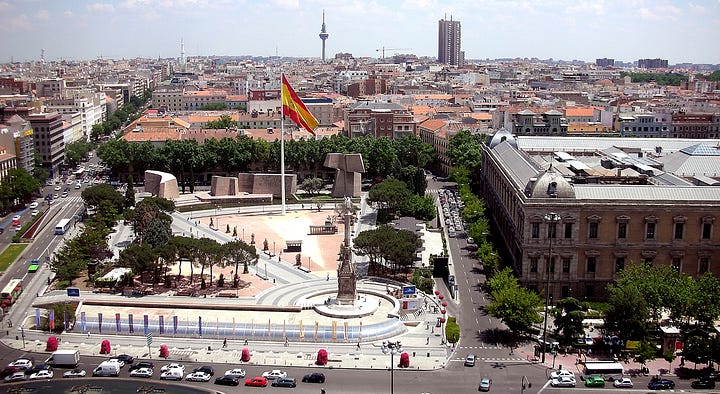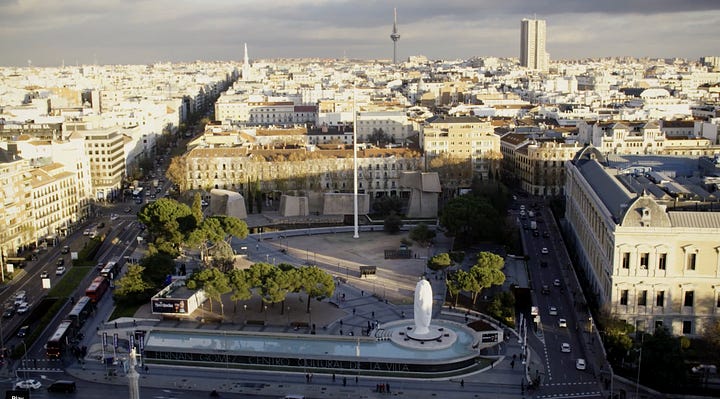😌 Madrid's 12-Meter Meditative Mistress
How a public sculpture became my patron saint and poster girl
Julia invites us into our inner sanctuary where calm and conflicting perspectives coexist.
She stands in Plaza Colón as if she's always been there, though she only made her debut in December 2018. A few people have told me I look like her, a compliment I gladly accept. Her face is distorted, but captivating and once you lay eyes on her, you’ll want to see her from every angle. There's something about seeing her that makes my insides relax and take a deeper breath. If she had a job description, it would be something like: “Preside over our people with peace.”
Dear readers, meet Julia—a sculpture I adore and shamelessly anthropomorphize, because some art demands to be loved like a person.
Julia is a 12-meter-high sculpture made of polyester resin and white marble powder, crafted by Catalan artist Jaume Plensa. She occupies the former pedestal where Christopher Columbus once stood and the swap feels symbolic.
Every Columbus statue I've ever seen looks outward—scanning horizons that lead to exploration, enslavement, and exploitation. By contrast, Julia’s closed eyes are looking inward—inviting us to pause, process, and persevere.
Plensa modeled her image from a girl from San Sebastian and describes her as representing “tenderness and silence” and hopes she'll “serve as a mirror to help recover serenity in society.”


Madrid is essentially one giant art gallery and Julia’s face stands as one of its most contemplative pieces. Her serene presence stands in direct opposition to the loud aggression that sometimes fills the plaza during political gatherings, where groups like Vox promote climate denial while attacking the rights of women, LGBTQIA+ people, and immigrants. Yet she also bears witness to calls for peace—the first time I saw her was at a rally in solidarity with Ukraine just days after Russia's invasion.
While my ability to comment on visual art feels undeveloped compared to my practice of unpacking Taylor Swift lyrics, art has a way of creating unexpected connections across time and space. When I saw Julia a week after arriving in Madrid, I recognized Jaume Plensa’s name and remembered I also saw his Talking Continents installation a few weeks after my move to Memphis.
Plensa's sculptures have twice been a quiet anchor for me during two big moves—times when I’m figuring out who I am in a new place while still carrying pieces of where I came from. His sculptures seem to understand that tension between individual experience and belonging to something larger.
Plensa’s work pulls me in, whether I'm taking in the whole thing or getting lost in all the tiny details, and maybe that's the point—we're both the small intricate parts and the bigger collective at the same time.
My Patron Saint and Poster Girl
When I started this blog in February 2024, Substack asked me to create a header logo for email subscribers. I scrolled through photos in my phone, trying to find something visually appealing that represents my experience in Madrid. The search ended with this photo:
After tinkering with a template in Canva, this header logo emerged:
And was updated in 2025 with brighter colors:
This photo, now featured in my header logo, holds much meaning. I took it during one of those particularly long stretches of long-distance marriage, on a Sunday evening when the city was full of families at Christmas markets. I was thrilled with how the light and composition came together, but also felt the deep ache of missing my person. I couldn't figure out how to express both things in a social media post, so I didn’t share it.
Julia invites us into our inner sanctuary where calm and conflicting perspectives coexist. She was an easy choice to be Americana en España poster girl.
I also picked this photo because it captures:
Madrid's signature sunset palette mixing neutrals with those warm and cool tones that make the whole city glow.
The elemental poetry of pool and sky reflecting each other until water becomes air becomes water again.
Julia’s westward orientation—toward home, toward the people I love, toward everything that felt, and feels, so far away.
Catch Her While You Can
Along one of Madrid's busiest streets, between the business district and the biblioteca nacional (national library), Julia sits unmoved and unbothered. She's teaching pigeons, tourists, and hurried madrileños to pause—to breathe, to look toward the horizon with intention rather than desperation.
Julia belongs to the itinerant Art Collection of the María Cristina Masaveu Peterson Foundation, meaning her Madrid residency has always been temporary, though she's been given extensions since 2018 and it’s possible she’ll be around until 2027. She’s an iconic nomad—people love having her here, but she was never meant to stay.
Julia's situation mirrors the immigrant experience: her ability to stay depends on funding, political winds, and navigating bureaucratic deadlines—a precarious dance familiar to anyone who's ever called a foreign country home.
One mystery remains: who keeps that pristine white head free of pigeon poop? She doesn't strike me as much of a talker, so I'll ponder her secret in silence.
I'll leave you with this three-minute installation video—can you believe this gorgeous face is held together with epoxy?
If we're lucky, Julia will remain Madrid’s serene sentinel a while longer, giving us permission to be still.
Have you seen any other Jaume Plensa installations (they’re all over the world) or have a public art piece that takes your breath away? Share it in the comments!











I managed to see all 6 of the Dambo trolls in the PNW before I left. Now I'm hoping to plan some trips to see others. They're so wonderfully whimsical! https://www.thomasdambo.com/trollmap
You do look like her! Do you know why her head is distorted? So interesting, thanks for sharing all this insight!